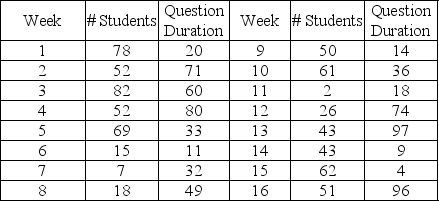Table 13-7
A professor dutifully holds six office hours per week as dictated by an archaic policy.Demand for office hours varies wildly as reflected in this historical data.
 The duration of time to answer questions varies independently from the actual demand.Question duration is reflected in this table.
The duration of time to answer questions varies independently from the actual demand.Question duration is reflected in this table.
 Entries in the student demand and question duration tables that reflect a range in demand, i.e., 3-9 students per six hours or 4-9 minutes should be treated as collapsed entries in the table.Thus, a question duration of 4 minutes has a 0.05 probability, a question duration of 5 minutes also has a 0.05 probability, and so on up through 9 minutes and a 0.05 probability.
Entries in the student demand and question duration tables that reflect a range in demand, i.e., 3-9 students per six hours or 4-9 minutes should be treated as collapsed entries in the table.Thus, a question duration of 4 minutes has a 0.05 probability, a question duration of 5 minutes also has a 0.05 probability, and so on up through 9 minutes and a 0.05 probability.
This table contains random numbers for the number of students and duration of question for a 16-week period.
 Use the question duration figure as the time required to answer questions for each student that week, so if three students arrive in week seven and the average duration is ten minutes, the total time spent answering questions that week is thirty minutes.
Use the question duration figure as the time required to answer questions for each student that week, so if three students arrive in week seven and the average duration is ten minutes, the total time spent answering questions that week is thirty minutes.
-Use the information in Table 13-7 to determine the range of random numbers that corresponds to 10 students showing up for office hours.
Definitions:
Noncash Investing
Investing activities that do not involve cash transactions, often involving the trade of assets or issuance of equity or debt.
Net Cash Flows
The difference between a company's cash inflows and outflows in a given period.
Financing Activities
Transactions related to raising capital and repaying investors, including issuing stocks or bonds and paying dividends.
Treasury Stock
Shares that were previously issued and outstanding but have been repurchased by the issuing company, reducing shareholders' equity.
Q6: Which of the following is not a
Q25: The number of phone calls coming into
Q31: The <img src="https://d2lvgg3v3hfg70.cloudfront.net/TB5481/.jpg" alt="The -chart
Q34: The logic in a simulation model is
Q34: Refer to Table 15-1.Bags of chocolate candy
Q42: Which of the following distributions is most
Q62: Thanks to a generous and eccentric donor,
Q64: CPM is a probabilistic analysis of managing
Q79: A quadratic programming problem involves which of
Q102: According to the information provided in Table